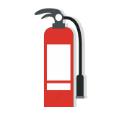
According to the “team of professional electricians” you should keep an eye for:Fires are one of the main reasons for injuries, or worse – causes of death. Fires are unpredictable, and so is a gas appliance malfunction. According to information published on the UK government’s official website, tragic fire hazard deaths are four times more likely to occur if a smoke alarm is not fitted in the rental property. That is why it is crucial not to overlook the range of Fire Safety practices, whose purpose is to prevent ignition and limit the progress of a fire, once it has started.
The following Fire Safety checklist includes all the significant measures you should consider, as it aims to offer you guidance.
 Potential Causes for Fire Hazards
Potential Causes for Fire Hazards
Fires need three ingredients to start: a heating source, fuel and oxygen. Keep ignition sources away from anything that can catch fire and burn.
 Keep sources of fire hazards in check
Keep sources of fire hazards in check
- Have you identified potential sources of ignition: open flames, electrical equipment, smoking areas, and hot processes?
- Have you identified potential fuel sources: flammable substances, furniture, outdoor waste storage spaces, packaging, plastic, foam, wallpaper, or wood?
 Who Can Be Put at Risk?
Who Can Be Put at Risk?
During a fire, there may be a higher risk for some people because they are more vulnerable, they are not adequately trained, or they are less familiar with the layout of the premises.
 People are at risk
People are at risk
- Have you determined if the staff’s safety is at risk?
- What about visitors, suppliers, and clients?
- Have you identified any vulnerable people, such as disabled people?
 Preventative Actions
Preventative Actions
Reduce fire risk by eliminating the most likely causes of fire. Identify potential accidental events and minimize cases of deliberate actions.
 What can be done to diminish the risk
What can be done to diminish the risk
- Have you reviewed smoking policies?
- Have you ensured that the risk of accidental ignition of any fire-conductive material is brought to a minimum (ex: heating sources and fuel sources are kept apart)?
- Have you taken comprehensive measures against an arson (ex: secure entry, breach of access to flammable goods)?
 Further Risk Reduction Measures
Further Risk Reduction Measures
These apply to daily activities on the premises, building maintenance, storage policies and anti-fire protection. Implement fire safety risk assessment processes by covering every aspect of your operations and the people involved.
 Additional monitoring and control
Additional monitoring and control
- Is the building in a good state of repair at all times (electrical wiring, vent systems, access/egress points)? According to the team of professional electricians you should keep an eye for electrical faults.
- Can daily operations and activities pose a fire risk and if yes, are prevention measures put in place?
- Are storage units regularly checked?
 Maintenance of Fire Safety Features
Maintenance of Fire Safety Features
Ensure that all existing fire safety features and access control points operate as they should.
 Regular review of fire safety devices
Regular review of fire safety devices
- Are fire doors in a good functioning order?
- Are access control door systems installed correctly and in compliance with relevant fire codes?
 Fire Warning Systems
Fire Warning Systems
The risk of damages and casualties during a fire is significantly reduced if people get a clear and timely warning.
 Staff and visitors are warned in time
Staff and visitors are warned in time
- Have you installed fire/heat/smoke/CO2 alarms throughout the premises? You should have at least one smoke alarm installed at each property floor.
- Are fire warning devices regularly checked for malfunctions?
 Clear Escape Route Signs
Clear Escape Route Signs
In the case of a fire breaking out, people must be able to vacate the premises safely and as quickly as possible.
 Plan an escape route
Plan an escape route
- Have you devised an adequate system of how everyone will leave the building to ensure their safety?
- Are fire escape and fire exit signs installed and maintained correctly, so they are visible in limited lighting conditions?
- Are there clear evacuation maps put in place?
 Safety Equipment Emplaced
Safety Equipment Emplaced
Damage control and safety measures include installing firefighting equipment at key points on the premises.
 Accessible fire extinguishers
Accessible fire extinguishers
- Are the fire extinguishers accessible and in a good working order?
- Do members of staff know how to prevent a small fire from spreading by using a fire extinguisher?
 Fire Drills & Evacuation Instructions
Fire Drills & Evacuation Instructions
Unless staff is instructed on how to act and what to do in the case of fire, the risk of things going wrong increases significantly.
 Fire drill practices
Fire drill practices
- Do you execute regular fire drills?
- Do you maintain fire drill records?
 Responsible Persons: Planning & Training
Responsible Persons: Planning & Training
Delegate responsibilities to selected persons in charge who conduct regular trainings, assign roles, plan and implement fire risk assessment systems and fire prevention practices.
 Nominate responsible persons
Nominate responsible persons
- Have you nominated members of staff to execute regular fire prevention training sessions?
- Does everyone understand their role (ex: who will call the fire services)?
- Have you ensured that temporary staff is also instructed?
 Risk Assessment Review
Risk Assessment Review
Changes of operations and work practices, as well as alterations to building structures may result in fire risk changes.
 Evaluate risk assessment plan
Evaluate risk assessment plan
- Do any changes call for a reevaluation of your fire risk assessment plan?
- Has a recent fire incident increased the risk and a review of your fire prevention practices need be applied?
- Do you conduct regular reviews of your fire risk assessment plan?
Check also:
FURTHER FIRE SAFETY INFORMATION:
If you need more information on fire prevention and safety, visit:
https://www.gov.uk/government/policies/fire-prevention-and-rescue




Leave a Reply